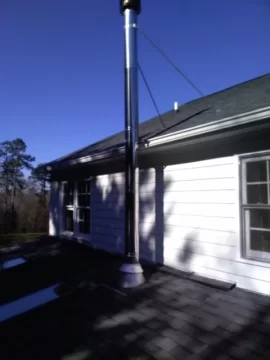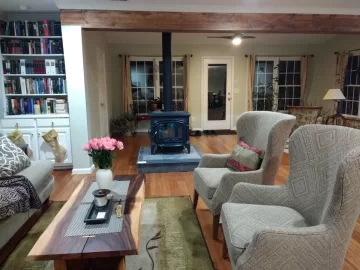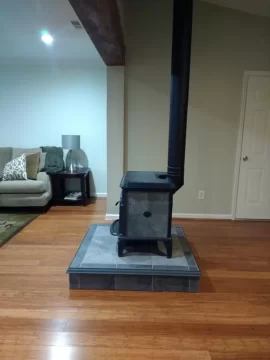I am new to wood burning, hence any help that I can get is greatly appreciated.
Problem: I can't get my new Hearthstone Phoenix 8612 above the 325F to 350F Temperature Zone. I have read endless threads here where Phoenix owners raise their ovens into the low to mid 400's in about an 1 and ½ or so.
Location: Greensboro, North Carolina.
Unit: Hearthstone Phoenix 8612 floor Model on display that was never used (Brand New). Unit has been checked out by installer.
Measurement: This is based on measuring the top center stone (per the manual) using a StoneGard/Condar Stove Top Thermometer.
Installation: The unit was professionally installed (see attached pics) in my townhome. We have building permits and were approved by the Greensboro, NC city inspectors.
1) Inside: Selkirk, 6" Double Wall Stove pipe.
2) Outside: Selkirk, Class A Stainless Steel Chimney Pipe. Set up exceeds the 2, 3, 10 rule. Total flue is ~ 21' from the top of the stove to the top of chimney cap.
Wood:
1) I use Home Depot (European White Burch) just to get the fire going. This is very dry of course (10 to 12 range).
2) Sometimes I use Home Depot (Simple Simon, mixed hardwood). This is very dry of course (10 to 12 range).
3) I have also used mixed hard woods from a local guy, with moisture in the 14 to 20 range.
4) I have also used hard wood (ASH) from a local guy, with moisture in the 15 to 20 range.
Tech Support: I have spoken to Hearthstone Tech support and tried everything under the sun, read the Manual front to back including tech bulletin #21. This bulletin states that a hot burn is between 350F to 375F. This is due to a modification involving 3 ceramic boards just underneath the top stones, sometime back in the late 90's. The manual has a range between 300F and 500F.Clearly, some owners are able to get these numbers and better.
Observations: I can build a fire (top or bottom method) , though sometimes I have to crack open the stove front door for a few minutes (no biggie here). From a cold start during the first load I can get the temperature to about 200F with Primary Air mostly open. During the second load I can get to ~300F maybe 325F and this is usually about the 1 and ½ hour point. If I obsess and continue to feed logs, then I may hit 350F on a good day. I have tried reducing the Primary air by 25% to 50%, but that does not really do much for me. I may get the middle Secondary Burn Tube going sometimes, but not the others. Anything more will choke the fire. It seems to me that EPA Stoves post numbers that are produced under very strict and unique nonrealistic lab conditions in order to pass emissions. Am I wrong about this?
Bottom Line: I have read endless threads that include the following (more draft, more air, dryer wood, home environment, operator error, learning curve, expectations, etc). I feel that my setup is for the most part well configured, but clearly not optimum. In other words, can I can do better? What am I doing wrong? Any help is greatly appreciated.
Problem: I can't get my new Hearthstone Phoenix 8612 above the 325F to 350F Temperature Zone. I have read endless threads here where Phoenix owners raise their ovens into the low to mid 400's in about an 1 and ½ or so.
Location: Greensboro, North Carolina.
Unit: Hearthstone Phoenix 8612 floor Model on display that was never used (Brand New). Unit has been checked out by installer.
Measurement: This is based on measuring the top center stone (per the manual) using a StoneGard/Condar Stove Top Thermometer.
Installation: The unit was professionally installed (see attached pics) in my townhome. We have building permits and were approved by the Greensboro, NC city inspectors.
1) Inside: Selkirk, 6" Double Wall Stove pipe.
2) Outside: Selkirk, Class A Stainless Steel Chimney Pipe. Set up exceeds the 2, 3, 10 rule. Total flue is ~ 21' from the top of the stove to the top of chimney cap.
Wood:
1) I use Home Depot (European White Burch) just to get the fire going. This is very dry of course (10 to 12 range).
2) Sometimes I use Home Depot (Simple Simon, mixed hardwood). This is very dry of course (10 to 12 range).
3) I have also used mixed hard woods from a local guy, with moisture in the 14 to 20 range.
4) I have also used hard wood (ASH) from a local guy, with moisture in the 15 to 20 range.
Tech Support: I have spoken to Hearthstone Tech support and tried everything under the sun, read the Manual front to back including tech bulletin #21. This bulletin states that a hot burn is between 350F to 375F. This is due to a modification involving 3 ceramic boards just underneath the top stones, sometime back in the late 90's. The manual has a range between 300F and 500F.Clearly, some owners are able to get these numbers and better.
Observations: I can build a fire (top or bottom method) , though sometimes I have to crack open the stove front door for a few minutes (no biggie here). From a cold start during the first load I can get the temperature to about 200F with Primary Air mostly open. During the second load I can get to ~300F maybe 325F and this is usually about the 1 and ½ hour point. If I obsess and continue to feed logs, then I may hit 350F on a good day. I have tried reducing the Primary air by 25% to 50%, but that does not really do much for me. I may get the middle Secondary Burn Tube going sometimes, but not the others. Anything more will choke the fire. It seems to me that EPA Stoves post numbers that are produced under very strict and unique nonrealistic lab conditions in order to pass emissions. Am I wrong about this?
Bottom Line: I have read endless threads that include the following (more draft, more air, dryer wood, home environment, operator error, learning curve, expectations, etc). I feel that my setup is for the most part well configured, but clearly not optimum. In other words, can I can do better? What am I doing wrong? Any help is greatly appreciated.




